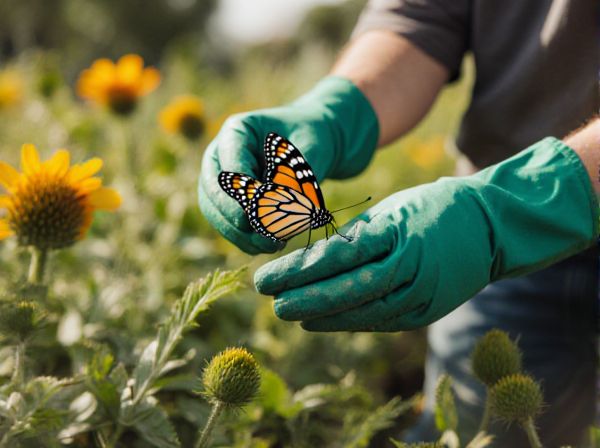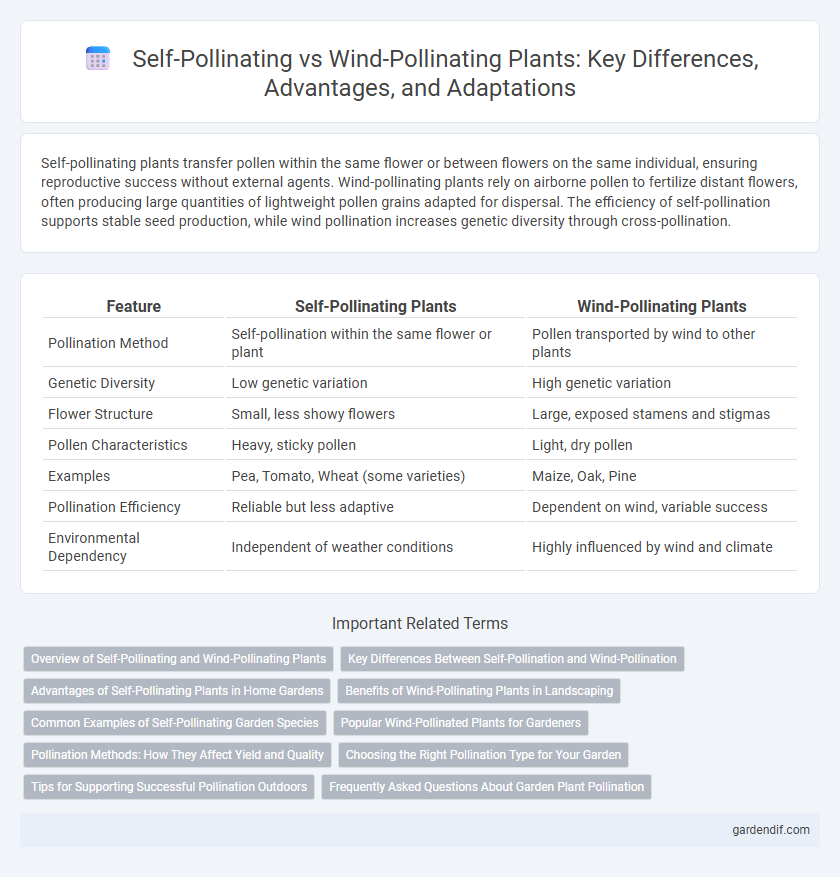
Self-pollinating vs Wind-pollinating Illustration
Self-pollinating plants transfer pollen within the same flower or between flowers on the same individual, ensuring reproductive success without external agents. Wind-pollinating plants rely on airborne pollen to fertilize distant flowers, often producing large quantities of lightweight pollen grains adapted for dispersal. The efficiency of self-pollination supports stable seed production, while wind pollination increases genetic diversity through cross-pollination.
Table of Comparison
| Feature | Self-Pollinating Plants | Wind-Pollinating Plants |
|---|---|---|
| Pollination Method | Self-pollination within the same flower or plant | Pollen transported by wind to other plants |
| Genetic Diversity | Low genetic variation | High genetic variation |
| Flower Structure | Small, less showy flowers | Large, exposed stamens and stigmas |
| Pollen Characteristics | Heavy, sticky pollen | Light, dry pollen |
| Examples | Pea, Tomato, Wheat (some varieties) | Maize, Oak, Pine |
| Pollination Efficiency | Reliable but less adaptive | Dependent on wind, variable success |
| Environmental Dependency | Independent of weather conditions | Highly influenced by wind and climate |
Overview of Self-Pollinating and Wind-Pollinating Plants
Self-pollinating plants, such as peas and tomatoes, transfer pollen within the same flower or between flowers of the same plant, ensuring consistent reproduction without relying on external factors. Wind-pollinating plants like grasses and many trees produce lightweight, abundant pollen that is dispersed by air currents to facilitate cross-pollination over long distances. These contrasting pollination strategies reflect adaptation to environmental conditions and influence genetic diversity and crop production methods.
Key Differences Between Self-Pollination and Wind-Pollination
Self-pollinating plants transfer pollen within the same flower or between flowers on the same individual, ensuring genetic consistency and reproductive assurance. Wind-pollinating plants rely on air currents to distribute pollen grains over long distances, promoting genetic diversity but requiring large quantities of pollen. Key differences include the mechanism of pollen transfer, the level of genetic variation, and the dependence on external environmental factors such as wind speed and direction.
Advantages of Self-Pollinating Plants in Home Gardens
Self-pollinating plants offer consistent fruit production and genetic stability, making them ideal for home gardens with limited space. They reduce dependency on external pollinators, ensuring reliable yields even in urban environments. This trait allows home gardeners to enjoy a steady harvest without needing specialized pollination techniques.
Benefits of Wind-Pollinating Plants in Landscaping
Wind-pollinating plants enhance biodiversity in landscaping by promoting cross-pollination, which increases genetic diversity and plant resilience. These plants reduce dependence on pollinators like bees, making them reliable in environments with limited insect activity. Their ability to produce large quantities of lightweight pollen ensures effective fertilization over wider areas, supporting healthy and sustainable garden ecosystems.
Common Examples of Self-Pollinating Garden Species
Common self-pollinating garden species include tomatoes, peas, and beans, which rely on their own pollen for fertilization, ensuring fruit and seed production even in isolated conditions. These plants exhibit traits like closed flowers or limited flower opening to promote self-fertilization and reduce dependence on external pollinators. Self-pollination enhances genetic consistency and is advantageous for gardeners seeking reliable yields without the variability introduced by wind or insect pollination.
Popular Wind-Pollinated Plants for Gardeners
Wind-pollinated plants, such as corn, rye, and oak trees, rely on air currents to transfer pollen grains between flowers, making them ideal for gardeners seeking low-maintenance pollination methods. Unlike self-pollinating plants, which fertilize themselves, wind-pollinated species typically produce large quantities of lightweight pollen to maximize dispersal efficiency. Incorporating popular wind-pollinated plants in gardens enhances biodiversity and supports a natural ecosystem balance without the need for insect pollinators.
Pollination Methods: How They Affect Yield and Quality
Self-pollinating plants, such as tomatoes and peas, rely on their own pollen for fertilization, ensuring consistent fruit set and often higher-quality yields with less dependency on external factors. Wind-pollinating species like corn and wheat depend on airborne pollen, which can lead to greater genetic diversity but may result in fluctuating yields due to environmental variability. Understanding the distinct pollination methods is crucial for optimizing crop management and improving both yield stability and product quality.
Choosing the Right Pollination Type for Your Garden
Self-pollinating plants like tomatoes and beans offer reliable fruit production without the need for external pollinators, making them ideal for small or indoor gardens. Wind-pollinating species such as corn and grasses require open spaces and adequate airflow to ensure effective pollen transfer between flowers. Selecting the appropriate pollination type depends on your garden's layout, climate, and the presence of pollinators to maximize crop yield.
Tips for Supporting Successful Pollination Outdoors
For successful pollination outdoors, provide diverse plant varieties to attract both self-pollinating and wind-pollinating species, ensuring genetic diversity and resilience. Minimize wind barriers such as dense hedges to facilitate the dispersal of pollen for wind-pollinated plants like maize and grasses. Maintain moist soil conditions and avoid excessive use of pesticides to support healthy pollinator activity and optimize seed production.
Frequently Asked Questions About Garden Plant Pollination
Self-pollinating plants like tomatoes and peas transfer pollen within the same flower or plant, ensuring consistent fruit production even in isolated garden conditions. Wind-pollinating plants such as corn and grasses release vast amounts of lightweight pollen into the air, relying on breezes to fertilize flowers over distance. Gardeners often ask whether wind-pollinated plants require companion planting or if self-pollinating species can thrive in small indoor gardens.
Self-pollinating vs Wind-pollinating Infographic

 gardendif.com
gardendif.com